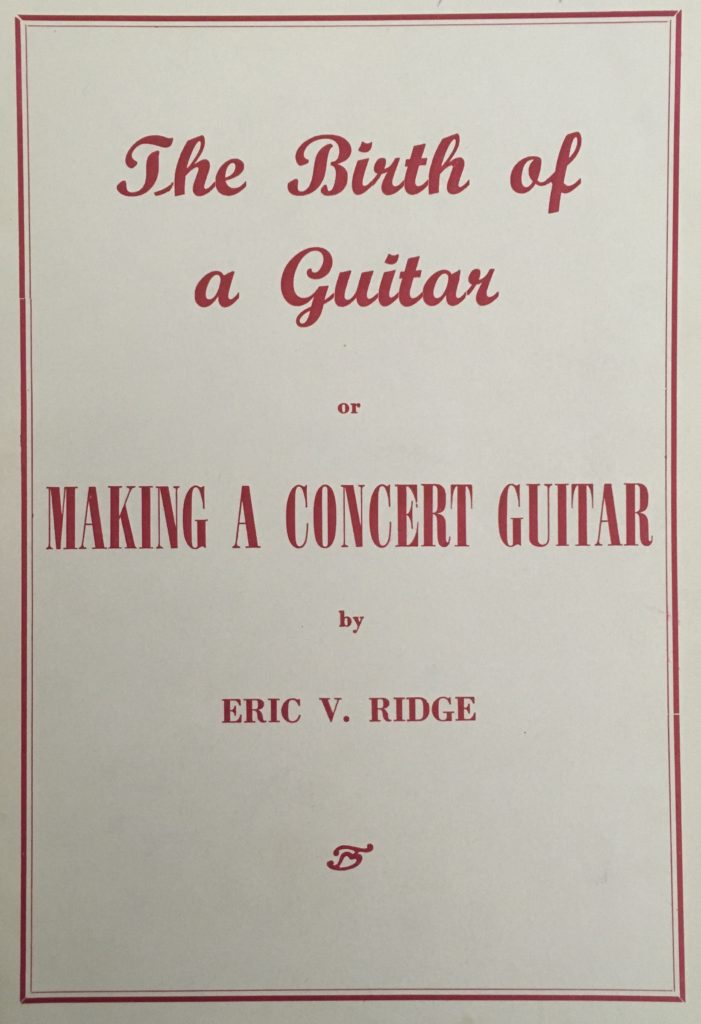
The making of ‘concert’ classical guitars in the UK began after World War II and at the same time, methodologies and techniques were explored and codified by amateur instrument makers. I am currently writing an article that will discuss this at length but in the meantime thought it would be of interest to some people to learn about another one of the artefacts I have come across during my research.
I have previously written about Theodorus M. Hofmeister’s plan of the Torres FE26 guitar, which was published in Guitar Review in 1954. I have also written about Clifford A. Hoing’s series of articles for Woodworker magazine in 1955. A similar series of articles by Eric V. Ridge was published in Guitar News in 1956-7 and later republished as a single publication in 1959.
Eric V. Ridge was a Committee member of the International Classic Guitar Association (ICGA) and an amateur instrument maker, having already made a few violins. He was encouraged by Wilfred M. Appleby, the Editor of the ICGA’s ‘official organ’, Guitar News, to make use of the Hofmeister plan to construct a guitar and write about his experience. Appleby had previously encouraged Clifford Hoing to write his series of articles for Woodworker and the Hofmeister plan may have been available to him, too.
In The Birth of a Guitar, Ridge writes:
“Owing to the dearth of information available to prospective guitar makers I was forced to the examination of existing instruments, both good and bad and the perusal of short articles which had appeared from time to time in various publications, combining my knowledge of woodworking, instrument making in particular, with a certain amount of commonsense.
I commenced therefore, after months of contemplation and experimenting, with a firm idea in my mind as to how I intended to proceed with my first instrument, free and untrammelled by the experiences and writings of past guitar makers, and if some of my ideas seem revolutionary, let me say here and now that at no time during the making of the instrument was anything done without due consideration and forethought.” (p.5)
“The best modern concert guitars are all based more or less on the model designed by the great Spanish guitar-maker, Torres, who has been called ‘the Stradivarius of the guitar’. I was fortunate to have the detailed plan and measurements of one of his finest instruments so I used these in planning my guitar”. (p.6)
Here are the first couple of ‘chapters’ from the 1959 reprint of Eric V. Ridge’s series of articles (click to enlarge):
The original series ran over six issues of Guitar News, from Oct/Nov 1956 to Sept/Oct 1957, coinciding with A.P. Sharpe’s book, Make Your Own Spanish Guitar, which was published in early 1957. An advertisement in Banjo Mandolin and Guitar (BMG) magazine in June 1957 claims that over 1000 copies of A.P. Sharpe’s book had already been sold.1 It was A.P. Sharpe’s book that Jose Romanillos used to make his first guitar and is also the guitar-making publication from that formative period that is most widely recognised today. To his credit, Romanillos also mentions the Hofmeister plan and Ridge’s series of articles in his book on Antonio de Torres, which is what led me to look for them in the Bodleian Library (Guitar Review) and British Library (Guitar News).
These four publications by Hofmeister (1954), Hoing (1955), Ridge (1956-7) and Sharpe (1957) constitute the foundational instruction on classical guitar making in the English language. It wasn’t until a decade later (1966) that Irving Sloane would publish Classic Guitar Construction, which Wilfred Appleby described as “the sort of ‘De Luxe’ book on the subject which we dreamed and hoped would eventually appear.”2





